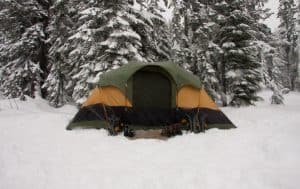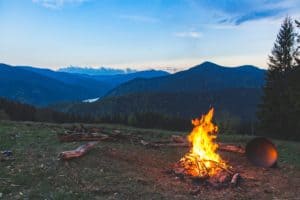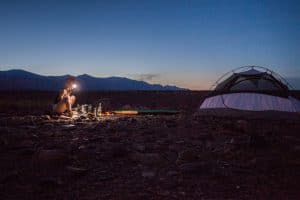The harsh weather often has no mercy upon whatever it finds in the open. And, one of these (always in the open) is the camper’s sole habitat — the tent.
But, no matter how hard the weather hits the canvas, it feels no pain — the camper does instead. Of all the weather types, however, there’s often no harsher than the penetrative cold.

The cold bites. It burns. It causes hypothermia. It robs the camper of sleep. The cold can kill!
So how exactly does the camper keep himself warm inside his vulnerable tent?
That’s what this article answers in seven expert-endorsed, tried and tested ways to stay warm in a tent. Let’s dive right into the list.
Quick Navigation
Bag A Hot Water Bottle
Then drink the hot water, right? No!
Let’s start with the type of bottle itself. I’ll recommend that you use a Nalgene bottle. It’s rated well for hot water. After filling it with some boiled water, you can throw it into your sleeping bag, some few minutes before you go to sleep. It’ll warm the bag for some 3-4 hours to come, and that’s mileage.
Then once you get into the bag, the bottle can find a new place to stay. You can place it at your feet, belly or crotch, wherever you feel fit.
As for me, the feet are my best position, but people have varying preferences. Some will find the belly to be a great place, while some may also place it by their sides. You have the freedom of choice here.
Use A Small Tent.
That is if you’re alone. Otherwise, you may have to use a bigger one.
The massive tent will have no mercy on you if you’re a solo camper, and the weather is unbearably cold. Just do the right thing. If a tent is meant for four, let four people occupy it, or you’ll have to bear the cold that should be borne by four, all alone. It’s pure science, the more space, the longer the time it takes to heat.
If you’re many, you will surely use a bigger tent. Your bodies will literally occupy more space, and the little remaining space will heat up quite faster than when you’re alone.
So the more you are, the quicker you heat, and vice versa. Don’t forget this simple rule.
Wear Apt Clothes
This sounds quite obvious. You’ll probably conclude that I simply mean some heavy clothes.

Okay, you’re right, but that’s not the whole thing.
On the head, I’ll recommend that you put on a knit hat instead of pulling your head into the sleeping bag. You lose more heat via the head, and a knit hat (wool) is the best gear to keep that heat on your body.

You should also put on heavy, dry socks and long, dry underwear. In all the cases, always make sure that the clothes are made of polyester and/or wool, but not cotton.
Why?
Because cotton is best at holding water close to the skin, a phenomenon that can have you lose heat so fast. Also, if the cold increases, you’re free to add more layers of clothing to increase insulation.
Get The Right Sleeping Pad
I dub this “investing in insulation” between your body and the underlying material (the ground or the mattress). Typically, an air mattress doesn’t offer sufficient insulation between your body and the trapped air.
Also, the ground itself is very cold, so you need something that can alleviate the contact. That’s where sleeping pads come in. Luckily, they can be used both on mattresses and on the ground, alike.

Get one with a temperature rating that conforms with the temperature of the area in which you’re camping.
Also, find a soft and larger one. You don’t want to slip off it, only to wake up shivering beyond normal.
Eat Right
So you’re like, really?
But, eating has got a lot to do with the heat in the body. I’ll explain it.
Your body often works by itself to regulate its own temperature. But, it needs some power to do so, and that power can only be fuelled by the right foods.
Make sure that you chow down some proteins and calorie-rich foods before you sleep. Some healthy fatty foods can also do the trick.
Remember that there are proteins and healthy proteins, fats, and healthy fats, in that order. You know what to go for.
Stay Hydrated, But Carefully.
Hey! I need some heat, why drink colds again? You may ask.
I said carefully, but I didn’t mean that you avoid cold drinks. In fact, gobble them up a bit, too. I’ll recommend that you take some warm drinks like coffee in the evening.
However, you should avoid much of it as hard as you can. The cold weather is often associated with frequent peeing, which isn’t a healthy ingredient to staying warm.
When you keep leaving the tent for a nature call, you’ll be breaking the heat you had built up before, thereby starting to regain the heat when you get back.
Additional Tip: You can save some bucks by using a multipurpose hot water bottle.
Keep Everything Dry
Sure. This is rational. Believe me, not, the dampest of clothes can always cause shivering in less than an hour, especially if the cloth is made of cotton.
Also, make sure that you don’t like up so many clothes that will get you to the point of sweating. I assume you know that sweat can lead back to cold from the explanation given above.
Remember: As I earlier mentioned, polyester and wool are the go-to materials.
Don’t Wait For The Cold!
Will you?
Just when the cold temperatures have started taking over the atmosphere, begin layering clothes. There’s no point in waiting until it’s too late. When you get warm earlier, it’ll be hard to lose all the heat. But, if you wait for the frigid temperatures, it will take time before you heat up back again. So be cautious by starting earlier.
The Bottom Line
If you pored over the whole article, you should now be one of the experts in keeping warm inside the tent. These seven godsend tips are the only way towards cozy camping.
Now, show your generosity by sharing the same advice to family, friends, and acquaintances.
My part is done.
Meanwhile, best of luck, pals!



